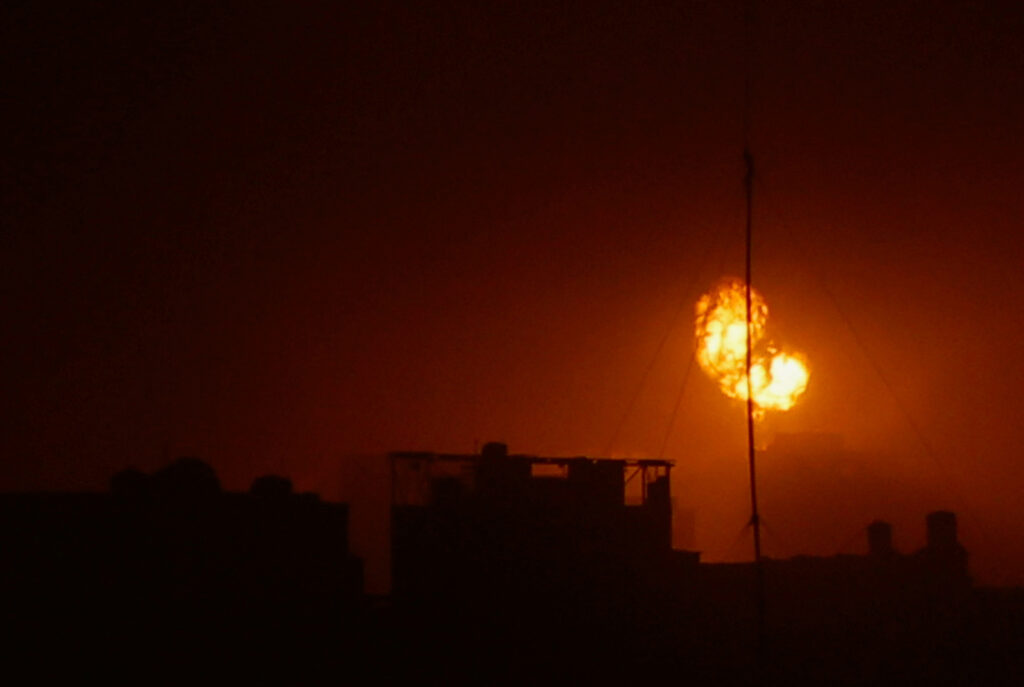
An explosion takes place during Israeli air strikes over Gaza, amid the ongoing conflict between Israel and the Palestinian Islamist group Hamas, in Khan Younis in the southern Gaza Strip, December 4, 2023. REUTERS/Ibraheem Abu Mustafa
GAZA — Intense Israeli air strikes hit the south of the Gaza Strip on Monday, killing and wounding dozens of Palestinians, including in areas where Israel had told people to seek shelter, residents and journalists on the ground said.
Israeli troops and tanks also pressed their ground campaign against Hamas militants in the south of the enclave after having largely gained control of the now-devastated north.
READ: Israel bombs Gaza as war resumes after truce with Hamas collapses
At the United Nations, Secretary-General Antonio Guterres appealed to Israel to avoid further action that would make the already dire humanitarian situation in Gaza worse, and to spare civilians from more suffering.
“For people ordered to evacuate, there is nowhere safe to go and very little to survive on,” U.N. spokesperson Stephane Dujarric said.
Israel’s closest ally the United States has repeatedly urged it to do more to protect civilians and said the Israeli offensive in the south should not repeat the “massive” civilian toll it has had in the north.
About 900 people have been killed in Israeli air strikes since a truce ended on Friday, Gaza health authorities said.
READ: Israel expands Gaza ground offensive
U.S. National Security Advisor Jake Sullivan said Washington expected Israel to avoid attacking areas identified as “no-strike” zones in Gaza.
Early on Monday, Israel ordered Palestinians to leave parts of Gaza’s main southern city, Khan Younis. But residents said that areas which they had been told to go to were also coming under fire.
Israel’s military posted a map on social media platform X with around a quarter of Khan Younis marked off in yellow as territory that must be evacuated at once.
Three arrows pointed south and west, telling people to head towards the Mediterranean coast and towards Rafah, a major town near the Egyptian border.
READ: Israel says it uncovered 800 shafts to Hamas tunnels below Gaza
Desperate Gazans in Khan Younis packed their belongings and headed towards Rafah. Most were on foot, walking past ruined buildings in a solemn and silent procession.
But the head of the United Nations agency for Palestinian refugees in Gaza (UNRWA), Thomas White, said people in Rafah were themselves being forced to flee.
“People are pleading for advice on where to find safety. We have nothing to tell them,” he said on X.
In the territory’s northern part, the official Palestinian news agency WAFA said at least 50 people were killed in an Israeli air strike that hit two schools sheltering displaced people in the Daraj neighbourhood of Gaza City.
The Gaza health ministry could not be reached for comment on the report and it was not immediately possible to verify it independently. A spokesperson for the Israeli army said it was looking into the report.
Separately, the health ministry said at least 15,899 Palestinians, 70% of them women or under 18s, have now been killed in Israeli bombardments of the Hamas-ruled enclave in eight weeks of warfare. Thousands more are missing and feared buried in rubble.
Israel launched its assault to wipe out Hamas in retaliation for an Oct. 7 cross-border attack by Hamas gunmen. They killed 1,200 people and seized 240 hostages, according to Israeli tallies – the deadliest single day in Israel’s 75-year history.
Over 100 of the hostages were freed during a seven-day truce. Israeli authorities say seven civilians and an army colonel died in captivity, while 137 hostages remain in Hamas-run Gaza, their condition not always known.
‘NO SAFE AREA’
Bombing at one site in Rafah overnight had torn a crater the size of a basketball court out of the earth. A dead toddler’s bare feet and black trousers poked out from under a pile of rubble. Men struggled with their bare hands to move a chunk of the concrete that had crushed the child.
Later they chanted “God is greatest” and wept as they marched through the ruins carrying the body in a bundle, and that of another small child wrapped in a blanket.
“We were asleep,” said Salah al-Arja, owner of one of the houses destroyed at the site. “They tell you it is a safe area, but there is no safe area in all of the Gaza Strip.”
Israel accuses Hamas of putting civilians in danger by operating from civilian areas, including in tunnels which can only be destroyed by large bombs. Hamas denies it does so.
As many as 80% of Gaza’s 2.3 million people have fled their homes in the Israeli bombing campaign that has reduced much of the crowded coastal strip to a desolate wasteland.
Israeli forces largely captured the northern half of Gaza in November, and since the truce collapsed on Friday they have swiftly pushed deep into the southern half.
Tanks have driven into Gaza from the border fence and cut off the main north-south route, residents say. The Israeli military said the central road out of Khan Younis to the north “constitutes a battlefield” and was now shut.
The commander of Israel’s armoured corps, Brigadier-General Hisham Ibrahim, told Army Radio the military had almost achieved its goals in northern Gaza.
“We are beginning to expand the ground manoeuvre to other parts of the Strip, with one goal – to topple the Hamas terrorist group,” he said.
(Reporting by Mohammed Salem in Gaza, Maayan Lubell, Ari Rabinovich and Emily Rose in Jerusalem, Maggie Fick in Beirut, and Andrew Mills in Doha; Writing by Peter Graff, Angus MacSwan and Humeyra Pamuk; Editing by Mark Heinrich, Jane Merriman and Rosalba O’Brien)